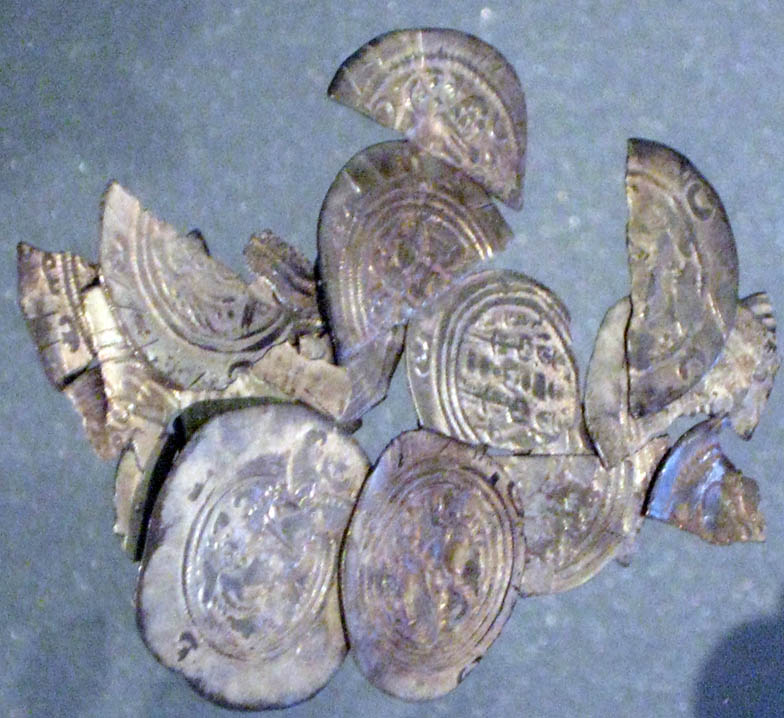|
Sundveda Hoard
The Sundveda Hoard ( sv, Sundvedaskatten) is a Viking Age hoard of 482 silver coins found in 2008 in Sundveda between Märsta and Sigtuna, not far from Stockholm in Sweden. It is the largest silver hoard found in the Mälaren region since 1827. Discovery The Sundveda Hoard was discovered by archaeologists from the Swedish National Heritage Board while conducting an examination of a grave in Sundveda. The examination was ordered by the County administrative board of Stockholm as part of preparatory works ahead of the construction of a new residential area. The finding of the hoard, which was described as a surprise, led to a more thorough examination of the grave. Apart from the silver hoard, bone fragments and other minor objects were discovered in the grave. Analyses showed that the bones were those of someone living at the middle of the 7th century, i.e., approximately 200 years before the hoard was placed there. Analysis of fragments of coal found in the grave, on the oth ... [...More Info...] [...Related Items...] OR: [Wikipedia] [Google] [Baidu] |
Carolingian Empire
The Carolingian Empire (800–888) was a large Frankish-dominated empire in western and central Europe during the Early Middle Ages. It was ruled by the Carolingian dynasty, which had ruled as kings of the Franks since 751 and as kings of the Lombards in Italy from 774. In 800, the Frankish king Charlemagne was crowned emperor in Rome by Pope Leo III in an effort to transfer the Roman Empire from Byzantine Empire to Europe. The Carolingian Empire is considered the first phase in the history of the Holy Roman Empire. After a civil war (840–843) following the death of Emperor Louis the Pious, the empire was divided into autonomous kingdoms, with one king still recognised as emperor, but with little authority outside his own kingdom. The unity of the empire and the hereditary right of the Carolingians continued to be acknowledged. In 884, Charles the Fat reunited all the Carolingian kingdoms for the last time, but he died in 888 and the empire immediately split up. With the on ... [...More Info...] [...Related Items...] OR: [Wikipedia] [Google] [Baidu] |
Archaeological Discoveries In Sweden
Archaeology or archeology is the scientific study of human activity through the recovery and analysis of material culture. The archaeological record consists of artifacts, architecture, biofacts or ecofacts, sites, and cultural landscapes. Archaeology can be considered both a social science and a branch of the humanities. It is usually considered an independent academic discipline, but may also be classified as part of anthropology (in North America – the four-field approach), history or geography. Archaeologists study human prehistory and history, from the development of the first stone tools at Lomekwi in East Africa 3.3 million years ago up until recent decades. Archaeology is distinct from palaeontology, which is the study of fossil remains. Archaeology is particularly important for learning about prehistoric societies, for which, by definition, there are no written records. Prehistory includes over 99% of the human past, from the Paleolithic until the adve ... [...More Info...] [...Related Items...] OR: [Wikipedia] [Google] [Baidu] |
Coins
A coin is a small, flat (usually depending on the country or value), round piece of metal or plastic used primarily as a medium of exchange or legal tender. They are standardized in weight, and produced in large quantities at a mint in order to facilitate trade. They are most often issued by a government. Coins often have images, numerals, or text on them. ''Obverse'' and its opposite, ''reverse'', refer to the two flat faces of coins and medals. In this usage, ''obverse'' means the front face of the object and ''reverse'' means the back face. The obverse of a coin is commonly called ''heads'', because it often depicts the head of a prominent person, and the reverse ''tails''. Coins are usually made of metal or an alloy, or sometimes of man-made materials. They are usually disc shaped. Coins, made of valuable metal, are stored in large quantities as bullion coins. Other coins are used as money in everyday transactions, circulating alongside banknotes. Usually the highest v ... [...More Info...] [...Related Items...] OR: [Wikipedia] [Google] [Baidu] |
Viking Treasure Troves
Vikings ; non, víkingr is the modern name given to seafaring people originally from Scandinavia (present-day Denmark, Norway and Sweden), who from the late 8th to the late 11th centuries raided, pirated, traded and settled throughout parts of Europe.Roesdahl, pp. 9–22. They also voyaged as far as the Mediterranean, North Africa, Volga Bulgaria, the Middle East, and North America. In some of the countries they raided and settled in, this period is popularly known as the Viking Age, and the term "Viking" also commonly includes the inhabitants of the Scandinavian homelands as a collective whole. The Vikings had a profound impact on the early medieval history of Scandinavia, the British Isles, France, Estonia, and Kievan Rus'. Expert sailors and navigators aboard their characteristic longships, Vikings established Norse settlements and governments in the British Isles, the Faroe Islands, Iceland, Greenland, Normandy, and the Baltic coast, as well as a ... [...More Info...] [...Related Items...] OR: [Wikipedia] [Google] [Baidu] |

.jpg)

